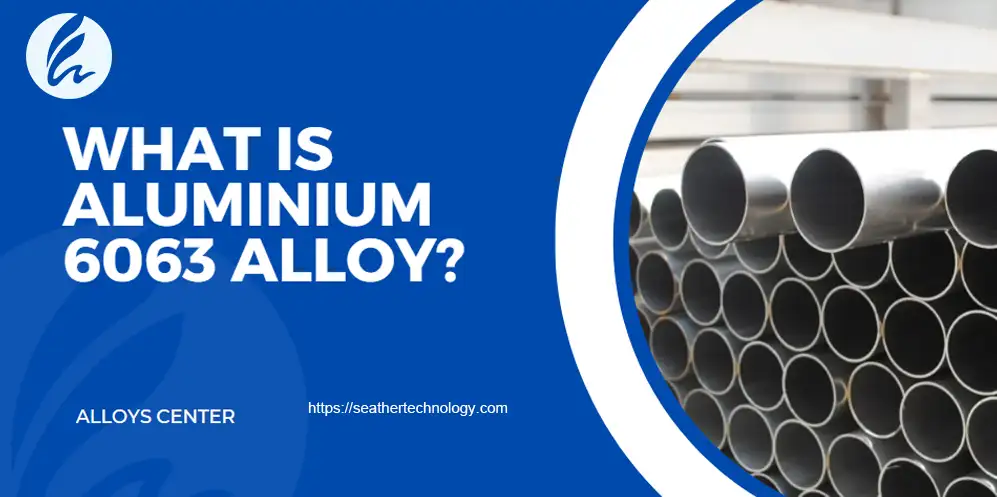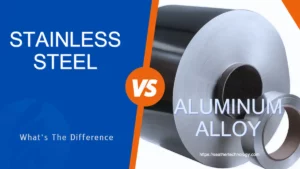Aluminum is a versatile material used very commonly these days due to its excellent properties and reasonable price.
Aluminum alloys are divided into different grades and series according to their compositions.
The 6061 aluminum and 6063 aluminum alloys are the most commonly used grades and belong to the 6000 series. This series contains magnesium and silicon as the main alloying elements.
The alloy strength is increased due to the magnesium, and the melting point is decreased due to the silicon.
These alloys are mostly used in the extrusion industry due to exceptional corrosion resistance and surface finish. These aluminum alloys belong to the same series, but still, there are differences in their chemical composition and mechanical properties.
6061 and 6063 aluminum alloys are a good choice for your project due to their excellent strength, workability, and corrosion resistance.
This article will help you to choose the right aluminum alloy material for your project. Learn more about the difference between 6061 and 6063 aluminum alloy.
6061 Aluminum Alloy Properties
Composition
Magnesium and silicon act as the main alloying elements in the 6xxx series of aluminum. The 6061 aluminum alloy contains 95.9~98.6% aluminum, 0.7% iron, 0.15~0.4 copper, 0.4~0.35% chromium, 0.15 % manganese, 0.8~1.2% magnesium, 0.15% titanium, 0.4~0.8% silicon, and 0.2% zinc.
Strength And Durability
The 6061 aluminum alloy is better in strength and durability than 6063 aluminum. Aluminum 6061 has a high tensile strength of 290 MPa or 42,060 psi. Therefore, it is commonly utilized in structural applications where aluminum’s high strength-to-weight ratio is the most important aspect.
Weldability
The welding process for 6061 Aluminum alloy has unique challenges; however, with the proper knowledge and procedures, these may be effectively solved. If aluminum alloy 6061 is welded without filler metal, solidification cracking will occur. It is critical to use the proper filler metal and welding processes to minimize the risk of cracking.
Machinability
The 6061 aluminum alloy is well-known for its outstanding machinability. While machining 6061 aluminum, selecting the appropriate tooling is important to attaining the best results. To minimize cutting forces and optimize chip evacuation, use carbide machine tools with sharp edges and a high helix angle.
Properties Of 6063 Aluminum Alloy

Composition
The 6063 aluminum alloy also belongs to the 6xxx series of aluminum and has a slightly different composition than the 6061 aluminum alloy. This alloy generally contains 0.35%, iron 0.1%, copper 0.1%, chromium 0.1%, manganese 97.5~99.4%, aluminum 0.45~0.9%, magnesium 0.2~0.6%, silicon, and max 0.1% zinc in its chemical composition.
Sturdiness & Strength
Aluminum 6063 is also known as the “architectural” alloy, and it is widely used in finishing applications due to its ease of extrusion and anodization. Anodizing the alloy improves its corrosion resistance. Aluminum 6063 has an excellent tensile strength (maximum stress load) of up to 240 Mpa.
Aluminum alloy 6063 is a better choice for utilizing salt and water medium due to its outstanding strength and corrosion resistance.
Weldability
Aluminum 6063 is highly weldable with tungsten inert gas welding. When welded, typically with tungsten inert gas welding, it will frequently suffer a strength loss of up to 30%, although it may then be heat treated to regain much of that strength.
Machinability
6063 aluminum is a medium-strength aluminum alloy frequently used in architectural applications. The aluminum alloy 6063 shows good machinability and surface finish; therefore, it is used in many applications. The addition of magnesium and silicon in the 6063 aluminum alloy plays a role in its good machinability.
6061 And 6063 Aluminum – Comprehend the Comparison
Chemical Composition
The following table compares the compositions of 6061 and 6063 aluminum alloys.
Alloying Elements | 6061 | 6063 |
Aluminum (Al) | 95.9~98.6% | 97.5-99.4% |
Iron (Fe)
| Max 0.7% | Max 0.35% |
Copper (Cu) | 0.15~0.4% | Max 0.1% |
Chromium (Cr) | Max 0.04~0.35% | Max 0.1% |
Manganese (Mn)
| Max 0.15% | Max 0.1% |
Magnesium (Mg) | 0.8~1.2% | 0.45-0.9% |
Titanium (Ti) | Max 0.15% | Max 0.1% |
Silicon (Si) | 0.4~0.8% | 0.2–0.6% |
Zinc (Zn) | Max 0.25% | Max 0.1% |
Others
| Up to 0.15% | Up to 0.15% |
Weldability & Soldering
Both the alloys have excellent weldability due to their composition. The heat treatment process of 6061 aluminum alloy may affect its weldability to some extent. Compared to 6063, the 6061 alloy is more prone to heat cracking during welding. Generally, 4xxx and 5xxx series of aluminum fillers (4043, 5356) are used for welding 6061 and 6063 alloys.
Surface Finish & Machinability
Compared to 6061 aluminum alloy, 6063 aluminum alloy offers a more eye-catching surface finish.
After anodizing, 6063 aluminum alloy can be used to create stunningly colored decorative surfaces.
Because 6063 aluminum alloy is ideal for anodizing, it is also used for visual construction, including window frames, door frames, roofing, and sign frames.
The 6061 aluminum alloy has better machinability than the 6063 aluminum alloy due to its higher strength.
Corrosion & Heat Treatability
If you want to choose a material between 6061 and 6063 that can be heat treated to improve mechanical qualities, 6061 alloy is the better choice.
Both 6061 and 6063 aluminum alloys show excellent corrosion resistance. Due to the fact that the concentration of copper in 6063 aluminum is quite low, 6063 aluminum is more corrosion-resistant than 6061 aluminum.
Extrudability
6063 aluminum alloy responds much better to extrusion than 6061 aluminum alloy. It is simple to create complex shapes, Including bars and tubes. Thus, 6063 aluminum is ideal for use in building materials. 6063 can be molded into complicated shapes using extrusion and other techniques.
Availability
6061 and 6063 aluminum alloys are the most widely available in the market due to their exceptional properties and huge demand. Both of these alloys are available in the form of plates, tubes, rods, sheets, and bars.
Which Aluminum Alloy To Choose?
Determine The Required Strength Resistance
The 6061 aluminum alloy is better in strength resistance than the 6063 aluminum alloy. It all depends on your project’s requirements. If more strength is required, then 6061 alloy is a better choice. The tensile strength 6061 is 130~410 MPa, while 6063 alloy has 110~300 MPa.
Determine The Surface Finish
Aluminum alloys mostly have good surface finishes, and both are known for their excellent appearance. However, 6063 aluminum alloy may have some advantages in terms of surface finish due to its extrusion qualities.
Consider The Cost And Availability
The price of an aluminum alloy is mostly determined by the specification of the aluminum material, raw materials, and the cost of processing. 6061 aluminum is marginally less expensive than 6063 aluminum due to the alloy’s more mature production process. Both of these alloys are easily available worldwide, especially in China and the USA.
Evaluate Formability And Machinability
Both of these alloys are malleable and easy to form. Compared to 6061, the formability of 6063 is a very good alloy 6063; therefore, it is very popular for extrusion, bending, and shaping applications. Both of these alloys are good in machining, but for the machining of 6061, we need special cutters tooling and controlled rate feed and speed because this alloy got more strength after the heat treatment.
Consider Welding And Joining Characteristics
These alloys show excellent welding and joining characteristics by using the filler metal. The heat-treating process can increase the strength and hardness of 6061 alloys. However, the heat treatment technique may have some effect on weldability. Compared to 6061, 6063 alloy has a lesser risk of hot cracking while welding. The decreased magnesium level in 6063 inhibits the production of brittleness.
Evaluate Heat Treatability
The 6061 aluminum is a heat-treatable alloy, which means we enhanced the properties of this alloy through heat treatment. The hardness and strength of these alloys are increased by heat-treating processes. Both 6061 and 6063 have good thermal treatability. Various tempering methods might enhance their functionality.
Check For Industry Or Regulatory Standards
Before selecting an aluminum alloy for your project, be sure it meets regulatory or industrial standards. The Aluminum Association (AA), based in the United States, has developed standards for aluminum alloys. You can readily find the AA standard for their temper levels.
Consult With An Expert Or Supplier
Before selecting an alloy between 6061 and 6063 for your project, it is very important to consult with a material expert or a supplier for guidance. We have expertise in aluminum alloys. You can easily contact us. Our material expert will provide complete guidelines and suggest the more suitable alloy for your project.
Conclusion
Grade 6061 and 6063 are very in-demand aluminum alloys due to their strength, corrosion resistance, surface finish, and formability.
Before selecting the alloy, you should check all the properties like machinability, surface finish weldability, thermal conductivity, heat treatability, and level of strength.
Contact Seather expert team for your customized aluminum project!






